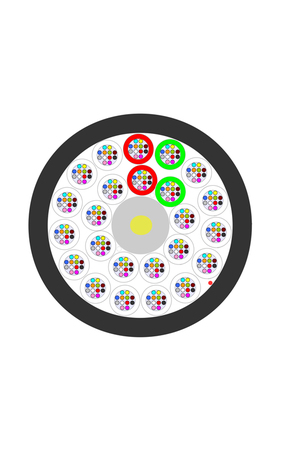Product Details
KDP
K1FZ049216B9AB
TP024176
A-DQ2Y 18X12E9/125G.652D BLK
New
Similar Products
Product Description
The 216FO (18x12) Air Blown Fiber Microduct Loose Tube Fiber Optic Cable SM G.652.D Black (Part number: K1FZ049216B9AB) from KDP with 216FO. Air blown microduct fiber cable is optimised for injection into microducts and is used in optical networks, more specifically for use in Fiber-to-the-home (FTTH) and Fiber-to-the-Desk (FTTD) networks. This technique that is lower at cost, quicker and more environmentally friendly than traditional deployment, allowing a simpler instalation with less resources.
The 216FO (18x12) Air Blown Fiber Microduct Loose Tube Fiber Optic Cable SM G.652.D Black from KDP is a Microduct Blowable Fiber cable with 216 fibers within 18 loose tubes. This distribution microcable for optical networks has a loose tube structure with a polyethyelene coated FRP dielectric central strength member and a UV stable polyethyelene outer sheath, allowing strenght and durability. Waterblocking yarns to prevent the progression of water inside the cable. The optical fibers comply with ITU-T recommendations G.652.D.
Applications
For outdoor use; Installation by blowing in microducts; FTTx
Characteristics
- Optical fiber
- Singlemode
- Loose tube
- Waterproof
- UV rays resistant
- Ripcords
- Exterior Diameter of cable 10,2 mm ± 0,4 mm
- Weight 87 Kg/km
*For technical specifications please see attached datasheet.
Product Specifications
Fiber Type (ITU) - OS2 G.652.D
Each type of single-mode fiber has its own area of application, and the evolution of these optical fiber specifications reflects the evolution of transmission system technology from the earliest installation of single-mode optical fiber to the present day. Choose the right fiber is very important for each project/installation. The specification of the OS2 fiber is generally considered as the SMF standard for the single-mode fiber. For the OS2 G.652 fiber there are 4 subcategories: G.652.A, G.652.B, G.652.C, G.652.D.
The OS2 G.652.D single-mode fibers are the most used type of fiber for networking and communications applications. The OS2 G.652.D fiber type provides a zero dispersion at 1310nm wavelength therefor it is optimized for operation in the 1310nm Wavelength. The regular performance remains on the 1550nm wavelength.
Benefits of using the OS2 G.652.D fibers:
- Backward compatibility with earlier versions;
- Lower system cost;
- Offers zero water peak and seamless splicing;
- Lower splicing losses;
- Supports longer cable runs.
FOC Construction - Loose tube
While using a loose tube construction in cables, you can:
- Pull and stretch without causing fractures from bending or tension;
- Have full resistant protection of the fiber core, cladding and coating (mechanical protection and UV protection);
- Reach optimized performances at extreme temperatures;
- Avoid the risk of environmental damage (including water damage).
The loose tube construction solution can be chosen for the following applications:
- Direct buried;
- Aerial;
- Duct;
- Rodent resistant;
- Indoor and outdoor;
- Water-blocking;
- Temperature endurance.
Fiber Mode - Single Mode (SM)
Single mode fiber uses a LASER light source, is a type of optical fiber with a small core diameter that allows only one mode of light to propagate. It is used in telecommunications and data transmission systems to transmit signals over long distances with low attenuation and high bandwidth. Single mode fiber is ideal for high-speed and long-distance applications, such as internet backbone networks, cable television networks, and fiber-to-the-home (FTTH) services. Its narrow core reduces the dispersion of light, allowing signals to travel further and faster than with multimode fiber.



.png?locale=en)




.png?locale=en)














